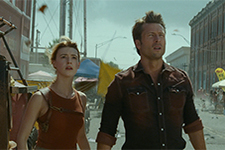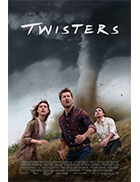Twisters
|  Jan De Bont’s Twister was a big hit in the summer of 1996, primarily due to the then-still novel presence of computer-generated effects. Disaster movies were making a comeback in the mid-1990s, fueled by the new possibilities that manipulated pixels could offer in creating erupting volcanoes, hurtling asteroids, and exploding buildings. The 1970s had given us a whole cavalcade of natural disasters on screens large and small—tsunamis (1972’s The Poseidon Adventure), earthquakes (1974’s Earthquake), hurricanes (1974’s Hurricane), floods (1976’s Flood), and even heat waves (1976’s Heatwave!) and swarms of the killer bees (1977’s The Swarm). Somehow tornadoes were left out of the genre, perhaps because the special effects demands were too great. Either that or filmmakers figured that Victor Fleming had directed the ultimate, never-to-be-bested twister in The Wizard of Oz (1939), so why bother? And then came De Bont, fresh off the action hit Speed (1994), armed with a screenplay co-written by Jurassic Park scribe Michael Crichton and an army of digital effects technicians, and he certainly gave audiences a ride. Of course, Twister was about as deep as the title suggests, with a thread-bare plot and paper-deep characters running around Oklahoma for the sole purpose of justifying another scene of tornadic destruction. Critics were rightly skeptical of what basically amounted to a theme-park ride masquerading as a movie (and, not surprisingly, it quickly became a simulation ride at Universal Studios), but audiences ate it up. For years, actor Bill Paxton, who played the lead in Twister, tried to mount a sequel of some kind, but it never took off, and the idea seemed to have died with him in 2017. But, here we are in 2024 with Twisters, whose plural title doesn’t denote a major difference from its predecessor since it also featured multiple twisters, not just one. Twisters is an accurate title, though, as there are a whole bunch of them tearing through the Oklahoma countryside (the only character that makes a repeat appearance from the original), and the great irony is that the goal of the protagonist is to use science to stop tornadoes. To say that she finally achieves that goal doesn’t reveal too much, nor does my telling you that a whole lot of tornadoes do a whole lot of damage before she figures it out. The character in question is Kate (Daisy Edgar-Jones), who we first meet as a gregarious college student chasing storms with her friends in an attempt to test her hypothesis that sending a lot of moisture-absorbing chemicals into the funnel of a rampaging twister will choke it out and stop it. Kate has an almost preternatural understanding of weather and a sixth sense that tells her when a storm will turn into a tornado and what it will do once its forms (one character later dubs her “the Tornado Whisperer”). Unfortunately, a major tragedy befalls this initial endeavor, and when we catch up with her five years later, she has exiled herself to New York City. She is tracked down by Javi (Anthony Ramos), one of her college friends who now works for a high-tech storm-chasing outfit known as StormPAR, which he recruits her to join temporarily. Kate is reluctant, but she is led to believe that it is for a greater good, which puts her right back in the middle of the tornadic juggernaut. It is here that she meets Tyler (Glen Powell), a blandly handsome, rip-roaring storm chaser with a big cowboy hat, a bigger belt buckle, and a million-subscriber YouTube channel who dubs himself “the Tornado Wrangler.” Tyler at first seems to be the obnoxious, attention-seeking, merchandise-selling opposite of everything Kate and her science-driven instincts stand for, but don’t be too quick to judge. Perhaps in response to the criticism of the original’s flimsy storyline, screenwriter Mark L. Smith (The Revenant, Overlord), working from a story by Joseph Kosinski (director of Top Gun: Maverick), punches up the plotting and characters, twisting some expectations and wringing a surprisingly decent amount of pathos out of their endeavors. Much of the plot hinges on why storm chasers do what they do—for science, for money, for the thrill of it all, or some combination of the above. Kate is a bit too much of a straight arrow, and her evolving relationship with Tyler has a cringey Hallmark vibe, but it works well enough. Politically speaking, Twisters threads a thin line; while there are no overt mentions of “climate change,” there are enough references to changing weather and increasing numbers of severe storms to allow liberals to read between the lines while conservatives can enjoy the carnage guilt-free. And what carnage there is. Tornados tear through small towns, obliterate buildings, tip over water towers, and send all manner of objects whirling through the air at terrifying speeds (alas, there are no airborne cows this time). Director Lee Isaac Chung, whose most recent film Minari (2020) was a huge critical hit, was a surprising choice given that all of his previous films have been relatively small-scale dramas. He handles the character drama better than a conventional “action director” might have, but he also proves to have a vivid sense of space and motion that turns the scenes of destruction into more than just rote action. While some of the twisters may blur together in your post-screening memory, Chung puts together a number of sequences that stick with you, including a climactic moment in a movie theater in which the wall with the screen is shorn away, opening a space through which we can see the tornado as if it were the most vivid 3-D presentation ever. Copyright © 2024 James Kendrick Thoughts? E-mail James Kendrick All images copyright © Universal / Warner Bros. |
Overall Rating: 

 (3)
(3)


